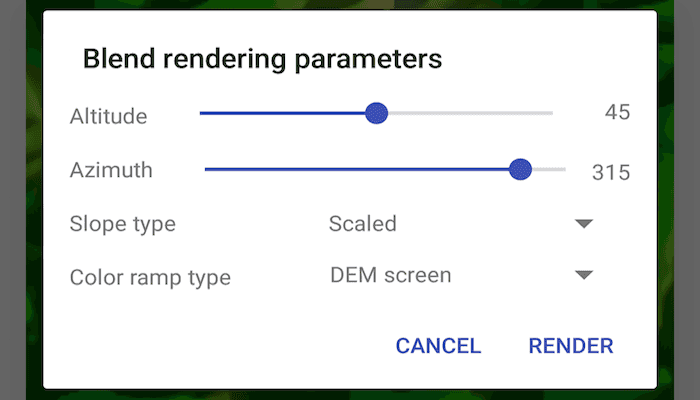Blend a hillshade with a raster by specifying the elevation data. The resulting raster looks similar to the original raster, but with some terrain shading, giving it a textured look.

Use case
A blend renderer can be used to apply a color ramp to a hillshade to emphasize areas of high or low elevation. A blend renderer can also be used to add a hillshade effect to aerial or satellite imagery, thereby making changes in elevation more visible.
How to use the sample
Choose and adjust the altitude, azimuth, slope type and color ramp type settings to update the image.
How it works
- Create a
Rasterobject from a raster file. - Create a
RasterLayerobject from the raster. - Create a
Basemapobject from the raster layer and set it to the map. - Create another
Rasterobject for elevation from a grayscale raster file. - Create a
BlendRendererobject, specifying the elevation raster, color ramp, and other properties.- If you specify a non-null color ramp, use the elevation raster as the base raster in addition to the elevation raster parameter. That way, the color ramp is used instead of the satellite imagery.
- Set the blend renderer to the raster layer.
Relevant API
- BlendRenderer
- ColorRamp
- Raster
- RasterLayer
Offline Data
- Download the data from ArcGIS Online.
- Extract the contents of the downloaded zip file to disk.
- Open your command prompt and navigate to the folder where you extracted the contents of the data from step 1.
- Push the data into the scoped storage of the sample app:
adb push Shasta.tif /Android/data/com.esri.arcgisruntime.sample.blendrenderer/files/Shasta.tif
Tags
color ramp, elevation, hillshade, image, raster, raster layer, visualization
Sample Code
/* Copyright 2017 Esri
*
* Licensed under the Apache License, Version 2.0 (the "License");
* you may not use this file except in compliance with the License.
* You may obtain a copy of the License at
*
* http://www.apache.org/licenses/LICENSE-2.0
*
* Unless required by applicable law or agreed to in writing, software
* distributed under the License is distributed on an "AS IS" BASIS,
* WITHOUT WARRANTIES OR CONDITIONS OF ANY KIND, either express or implied.
* See the License for the specific language governing permissions and
* limitations under the License.
*
*/
package com.esri.arcgisruntime.sample.blendrenderer;
import java.io.File;
import java.util.Collections;
import android.os.Bundle;
import android.view.Menu;
import android.view.MenuInflater;
import android.view.MenuItem;
import androidx.appcompat.app.AppCompatActivity;
import androidx.fragment.app.FragmentManager;
import com.esri.arcgisruntime.layers.RasterLayer;
import com.esri.arcgisruntime.mapping.ArcGISMap;
import com.esri.arcgisruntime.mapping.Basemap;
import com.esri.arcgisruntime.mapping.view.MapView;
import com.esri.arcgisruntime.raster.BlendRenderer;
import com.esri.arcgisruntime.raster.ColorRamp;
import com.esri.arcgisruntime.raster.Raster;
import com.esri.arcgisruntime.raster.SlopeType;
public class MainActivity extends AppCompatActivity implements ParametersDialogFragment.ParametersListener {
private MapView mMapView;
private File mImageFile;
private File mElevationFile;
private int mAltitude;
private int mAzimuth;
private double mZFactor;
private SlopeType mSlopeType;
private ColorRamp.PresetType mColorRampType;
private double mPixelSizeFactor;
private double mPixelSizePower;
private int mOutputBitDepth;
private FragmentManager mFragmentManager;
@Override
public void returnParameters(int altitude, int azimuth, SlopeType slopeType, ColorRamp.PresetType colorRampType) {
//gets dialog box parameters and calls updateRenderer
mAltitude = altitude;
mAzimuth = azimuth;
mSlopeType = slopeType;
mColorRampType = colorRampType;
updateRenderer();
}
@Override
protected void onCreate(Bundle savedInstanceState) {
super.onCreate(savedInstanceState);
setContentView(R.layout.activity_main);
//set default values for blend parameters
mAltitude = 45;
mAzimuth = 315;
mZFactor = 0.000016;
mSlopeType = SlopeType.NONE;
mColorRampType = ColorRamp.PresetType.NONE;
mPixelSizeFactor = 1;
mPixelSizePower = 1;
mOutputBitDepth = 8;
// retrieve the MapView from layout
mMapView = findViewById(R.id.mapView);
mFragmentManager = getSupportFragmentManager();
// create raster files
mImageFile = new File(getExternalFilesDir(null) + getString(R.string.imagery_raster_name));
mElevationFile = new File(getExternalFilesDir(null) + getString(R.string.elevation_raster_name));
// create a map
ArcGISMap map = new ArcGISMap();
// add the map to a map view
mMapView.setMap(map);
updateRenderer();
}
/**
* Creates ColorRamp and BlendRenderer according to the chosen property values.
*/
private void updateRenderer() {
// if color ramp type is not None, create a new ColorRamp
ColorRamp colorRamp = mColorRampType != ColorRamp.PresetType.NONE ? new ColorRamp(mColorRampType, 800) : null;
// create rasters
Raster imageryRaster = new Raster(mImageFile.getAbsolutePath());
Raster elevationRaster = new Raster(mElevationFile.getAbsolutePath());
// if color ramp is not NONE, color the hillshade elevation raster instead of using satellite imagery raster color
RasterLayer rasterLayer = colorRamp != null ? new RasterLayer(elevationRaster) : new RasterLayer(imageryRaster);
mMapView.getMap().setBasemap(new Basemap(rasterLayer));
// create blend renderer
BlendRenderer blendRenderer = new BlendRenderer(
elevationRaster,
Collections.singletonList(9.0),
Collections.singletonList(255.0),
null,
null,
null,
null,
colorRamp,
mAltitude,
mAzimuth,
mZFactor,
mSlopeType,
mPixelSizeFactor,
mPixelSizePower,
mOutputBitDepth);
rasterLayer.setRasterRenderer(blendRenderer);
}
@Override
public boolean onCreateOptionsMenu(Menu menu) {
MenuInflater inflater = getMenuInflater();
inflater.inflate(R.menu.blend_parameters, menu);
return super.onCreateOptionsMenu(menu);
}
@Override
public boolean onOptionsItemSelected(MenuItem item) {
ParametersDialogFragment paramDialog = new ParametersDialogFragment();
Bundle blendParameters = new Bundle();
//send parameters to fragment
blendParameters.putInt("altitude", mAltitude);
blendParameters.putInt("azimuth", mAzimuth);
blendParameters.putSerializable("slope_type", mSlopeType);
blendParameters.putSerializable("color_ramp_type", mColorRampType);
paramDialog.setArguments(blendParameters);
paramDialog.show(mFragmentManager, "param_dialog");
return super.onOptionsItemSelected(item);
}
@Override
protected void onPause() {
super.onPause();
mMapView.pause();
}
@Override
protected void onResume() {
super.onResume();
mMapView.resume();
}
@Override
protected void onDestroy() {
super.onDestroy();
mMapView.dispose();
}
}